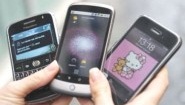Engineers Harvest Waste LCD Light To Charge Phones

Engineers in California have developed a method for converting wasted display light back to electricity
Engineers have opened the way for mobile devices to be charged using light generated from their own LCD displays.
Ambient light and sunlight could also be harnessed, using technology developed by researchers at California’s UCLA Henry Samueli School of Engineering and Applied Science.
LCDs (liquid crystal displays) – common in smartphones, tablets and laptops – sandwich tiny liquid crystals between two polarised sheets. Each of these crystals forms a pixel on the screen, and these pixels act as light valves for a device’s backlight. Combined by the millions, these create images on LCDs.
 The university engineers, supported by Intel, have created a new type of energy-harvesting polariser for LCDs called a polarising organic photovoltaic. Based on similar technology to solar panels, it works simultaneously as a polariser, a photovoltaic device and an ambient light or sunlight photovoltaic panel.
The university engineers, supported by Intel, have created a new type of energy-harvesting polariser for LCDs called a polarising organic photovoltaic. Based on similar technology to solar panels, it works simultaneously as a polariser, a photovoltaic device and an ambient light or sunlight photovoltaic panel.
Game changer
“I believe this is a game-changer invention to improve the efficiency of LCD displays,” said Yang Yang, a professor of materials science at UCLA Engineering and principal investigator on the research.
“In addition, these polarisers can also be used as regular solar cells to harvest indoor or outdoor light. So next time you are on the beach, you could charge your iPhone via sunlight.”
Yang’s research says LCD backlights can consume 80 to 90 percent of a devices power, yet 75 percent of light generated is lost through the polarisers. Potentially, 75 percent of this wastage can be converted back to electricity.
His team hopes to improve the efficiency of their solution in the near future before beginning work with major electronics manufacturers to take it mainstream.
The UCLA team’s full findings will be published in the Advanced Materials journal.